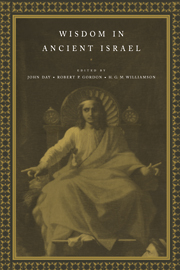Book contents
- Frontmatter
- Contents
- List of abbreviations
- Introduction
- Part 1 The ancient near eastern setting
- Part 2 Old Testament and Apocryphal texts
- Part 3 Themes
- 17 Were there schools in ancient Israel?
- 18 The trees, the beasts and the birds: fables, parables and allegories in the Old Testament
- 19 The personification of Wisdom
- 20 Wisdom and the goddess
- 21 Wisdom at Qumran
- 22 The interpretation of wisdom in nineteenth-century scholarship
- 23 Wisdom and Old Testament theology
- Biographical note: John Adney Emerton
- Bibliography of the works of John Adney Emerton
- Indexes
- Principal biblical and apocryphal references
18 - The trees, the beasts and the birds: fables, parables and allegories in the Old Testament
Published online by Cambridge University Press: 16 October 2009
- Frontmatter
- Contents
- List of abbreviations
- Introduction
- Part 1 The ancient near eastern setting
- Part 2 Old Testament and Apocryphal texts
- Part 3 Themes
- 17 Were there schools in ancient Israel?
- 18 The trees, the beasts and the birds: fables, parables and allegories in the Old Testament
- 19 The personification of Wisdom
- 20 Wisdom and the goddess
- 21 Wisdom at Qumran
- 22 The interpretation of wisdom in nineteenth-century scholarship
- 23 Wisdom and Old Testament theology
- Biographical note: John Adney Emerton
- Bibliography of the works of John Adney Emerton
- Indexes
- Principal biblical and apocryphal references
Summary
In his introduction to the Old Testament, O. Eissfeldt divides narratives into two groups: poetic narratives and historical narratives. The poetic narratives are subdivided further into several groups including myths, fairy-tales, fables, tales and sagas. Eissfeldt identifies examples of fairy-tale motifs in Num. xxii 22–35, where Balaam's ass is a talking animal, and 1 Kings xvii 1–6, where ravens bring food to Elijah. Like many scholars, he points out the excellent examples of fables in Judg. ix 8–15 (Jotham's fable) and 2 Kings xiv 9 (Jehoash's fable). In the allegories of Ezekiel, he notes the fable of the eagle, the cedar and the vine (xvii 3–10). Animals or vines appear together with humans in 2 Sam. xii 1–4, Nathan's parable of the poor man's ewe lamb, and Isa. v 1–7, the parable of the vineyard.
G. Fohrer, on the other hand, discusses fable, parable and allegory under the heading, ‘The Literary Types of Wisdom and their Traditions’. However, he includes most of the examples chosen by Eissfeldt and identifies them in the same manner, though we might note that he lists three allegories from Ezekiel: xvii 1–10, xix 1–9, xxxi 1–18. An ‘extended’ allegory is recognized in Eccles. xi 9–xii 8. Fohrer discusses the fairy-tale in his section on narrative literary types.
C. Kuhl, discussing the literary character of the Old Testament, writes: ‘In addition to this mythical material there is much in the Old Testament that smacks of the world of the MÄrchen, particularly in the writings of the prophets’.
- Type
- Chapter
- Information
- Wisdom in Ancient Israel , pp. 212 - 221Publisher: Cambridge University PressPrint publication year: 1995



